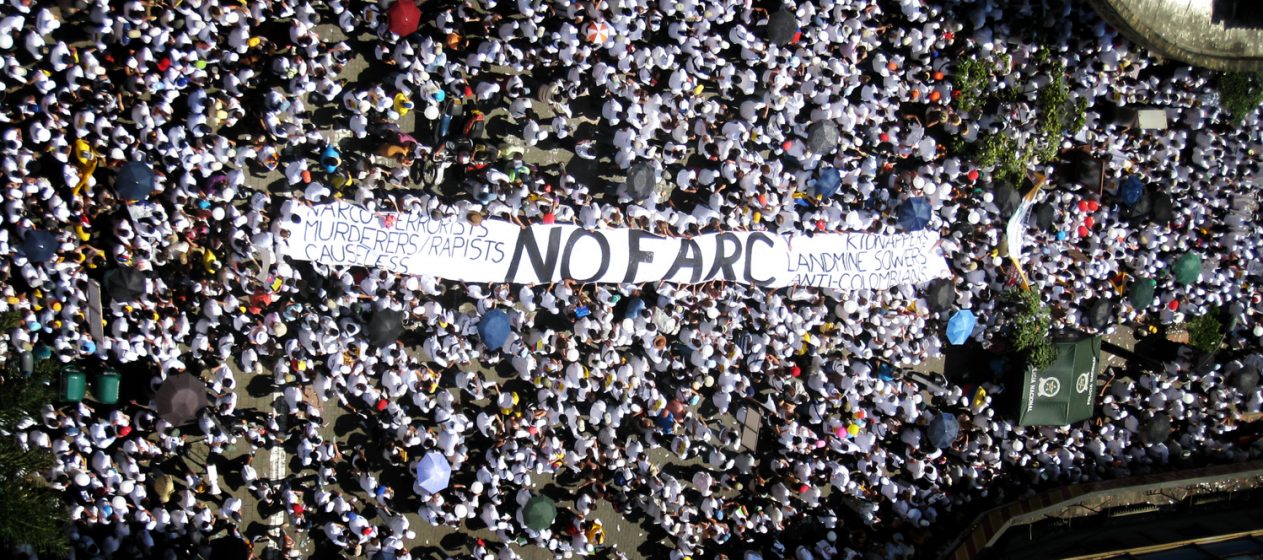The “how” and the “when” of Colombia’s latest peace breakthrough are of course important — but so is the “where” and “with whom.” On June 23, the Colombian government and the Revolutionary Armed Forces of Colombia-People’s Army (FARC) signed a bilateral ceasefire agreement, after more than five decades of armed conflict. For Colombia’s peace process to succeed, it will need to break the cycle of conflict, organized crime and state neglect in Colombia’s border regions.
The agreement stipulates that the FARC lay down its weapons within 180 days of a final peace deal, which has a July target date. The disarmament will take place in 23 specific “normalization zones” and eight camps, all of which cease to exist after these 180 days. The United Nations will collect weapons and monitor the process.
My research on Colombia’s violent non-state groups shows that the FARC and National Liberation Army (ELN), along with other groups, are deeply entrenched in many of these border areas. Finding a peace solution that accounts for the interests of these groups — but also breaks up the vicious cycle of state neglect and organized crime that has driven much of the conflict — will be essential tandem goals.
These areas are largely outside central government control.
On June 24, the Colombian Ministry of Defense announced the locations of the normalization zones, which include five regions close to the country’s border: La Paz in Cesar, Tibú in Norte de Santander, Tumaco in Nariño, Puerto Asís in Putumayo and Arauquita in Arauca. One of the eight designated camps also is located in a border department: Fonseca in La Guajira.
Over the past five years, I’ve interviewed many local stakeholders in these areas, including ex-combatants, traffickers, military officials, displaced people, civil society leaders and clerics.
These are FARC strongholds, but also territories in which the ELN, Colombia’s second-largest insurgent group, operates. On March 30, the ELN signed a framework agreement in Caracas to formally launch peace talks, but these talks have yet to begin. These territories are also home to numerous groups involved the drug trade and other transnational organized crime, including right-wing groups that evolved from paramilitary groups demobilized between 2003 and 2006. Even Mexican cartels operate in Colombia’s borderlands.
It’s no coincidence that these border areas have a number of violent groups, as the Colombian state historically has abandoned these regions. Without state institutions or state governance, FARC, ELN and right-wing groups in many instances essentially replaced the state. This phenomenon occurs across the globe, with violent non-state players providing such basic services as health and road infrastructure. But civilians in these areas face multiple security threats.
From my extensive fieldwork in these marginalized regions in Colombia, I learned that people often make a pragmatic decision to support FARC or ELN, rather than an ideological choice. Whichever group will help inhabitants survive guides this choice.
In Arauca and Putumayo, for example, violent non-state groups are in control, not the government. Bordering Venezuela and Ecuador, respectively, these two regions are dominated by the cocaine trade and other forms of transnational organized crime, including gasoline smuggling. The FARC controls much of Putumayo, while ELN and to some extent FARC are the illicit actors governing parts of Arauca.
In the absence of legal economic opportunities, local communities depend on coca farming or smuggling activities. They also benefit from conflict resolution mechanisms provided by these groups to solve disputes between neighbors and inhibit theft, rape and other forms of crime. These groups provide the rules to help communities regulate their daily lives — albeit by undemocratic means. In Puerto Asís, one of the designated zones, people complained to me that state forces step in to protect oil reserves, but not the people who live there.
So what happens to all of these armed groups?
Any potential peace agreement with the FARC therefore raises a number of questions: What will happen to all those other armed groups who operate in Colombian territory and across the borders? Who will take care of the local population and provide economic opportunities? Who will be deciding on the rules of behavior that people need to follow to be safe? Will these marginalized regions face an upsurge in violence or see wider peace?
These uncertainties are linked to the nature of the “normalization zones” announced on June 24. The ceasefire agreement spelled out some details — for example, FARC members can prepare for reintegration into civilian life by using these zones, which will have a one-kilometer wide safety ring. No civilians will be allowed to enter the FARC camps to ensure the rebels’ security. Once the zones cease to exist after six months, however, grievances will continue. This will fuel acts of retaliation by other armed groups against ex-combatants.
It’s even less clear what happens to the civilian populations living in or near these zones. Some may be stigmatized as FARC collaborators. Not being able to count on the FARC’s protection anymore, their lives are at risk as they are exposed to violence committed by other armed actors. Hard-working farmers may have new grievances if excluded from the benefits accorded to ex-combatants for demobilizing. And demobilized FARC members in FARC strongholds will likely have greater legitimacy than central state representatives, which will make it difficult for the government to strengthen democratic processes at the local level.
In territories where both FARC and ELN operate, the success of the FARC’s demobilization will partly depend on the ELN. Arauca, for example, which comprises the normalization zone of Arauquita, has to prepare for a potential strengthening of the ELN and an upsurge of violence. From 2006 to 2010, FARC and ELN were at war in Arauca.
After brutal fighting during these years they decided to adhere to a pact of nonaggression. They now share the territory but there is lingering mistrust. The ELN has more political clout here, including influence among government authorities in the departmental capital city of Arauca, which includes strategic corridors of the drug trafficking route toward Venezuela. As community members told me earlier this year, ELN may fight and attack ex-FARC members to regain control or simply expand their area of control by co-opting FARC supporters. Furthermore, ex-FARC members who are unwilling to disarm may opt to join the ELN rather than integrate into civilian life.
If the ELN sign a peace agreement relatively quickly after the FARC peace deal, the two groups could perhaps avoid violence. But local politics will constitute a major challenge. The population is likely to support whichever group — or its political successor — previously imposed the rules of the game and took care of the community. This support can derive either from a sense of respect or fear. There will be little support for a new political agenda based on a participatory process unless local communities understand such processes and receive protection from the state – and people see that the democratic process will indeed bring more benefits and security than before.
Third parties also could take advantage of the situation once the FARC lay down their arms. A number of paramilitary groups recently seem to be growing stronger, and may be in a better position than the state to fill the power vacuum the FARC leave behind. If paramilitary groups, rather than Bogotá, govern these spaces, further violence and oppression is likely in Colombia.
There is a path to peace
My research on post-conflict strategies for Colombia’s border areas suggests that better communication can help connect the disjointed people of Colombia’s peripheral regions, and promote peace as a common goal. Bogota is good in painting a picture of peace to the international community. But within its own borders, people on the margins lack information on how such peace should look, what concrete benefits they will get and why they should trust the government now, given that it has never cared for these people before.
Instead of making empty promises, Bogotá must explain how it will meet them. During my fieldwork in La Guajira and Arauca this year, I met people for whom the peace process was something between distant elites in Bogotá or in Havana, and not something that involved the people in the affected regions.
Transnational players also can help build new capacities on the ground. Across Colombia’s borders, NGOs, the church, academia and commerce groups all can help boost sustainable economic cross-border opportunities. These opportunities, in turn, can interrupt drug trafficking and other crime.
In a post-agreement scenario, Bogotá can gain credibility and legitimacy by partnering with ex-combatants in regions where the FARC and ELN have been acting as the government. Decades of state neglect have shaped an uncertain life in Colombia’s peripheral regions: a life with violence, but without electricity, drinking water and roads. The government needs to listen to the voices of the country’s neglected war zones and take their concerns seriously.
This post originally appeared in The Monkey Cage at The Washington Post on 28th June 2016.




